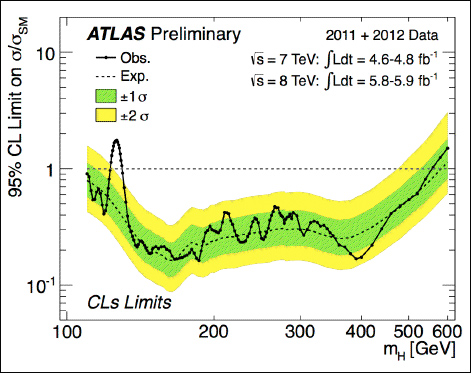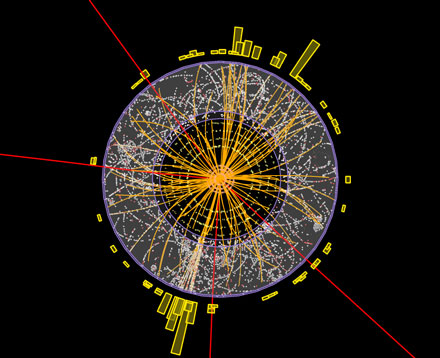Taking a closer look at LHC
Why do particles have mass? Why are the masses what they are? Why are the ratios of masses what they are?
The standard model describes everything we know about the smallest building blocks of nature yet observed. It's the most accurate theory ever developed, in any field. And without the Higgs, it doesn't make much sense. Based purely on first principles, elementary particles should be massless. Some, like photons, do have zero mass; yet others are surprisingly heavy. Enterthe Higgs, which would—in theory—interact with these latter particles to make the difference.
At the bottom of this page, an analogy is introduced by comparing refractive index and mass, to help to understand how Higgs field works.
|
In the Sixties, independently Peter Higgs, Francois Englert, Robert Brout, Gerald Guralnik, Dick Hagen and Tom Kibble, proposed that the universe was full of a field later called as HIGGS FIELD. But other theorists came up with similar ideas, and earlier publications helped pave the way. The size of this crowd may trouble a certain Swedish committee, as the annual Nobel Prize for physics can be awarded to three living scientists at most.
Disturbances in this field as particles move through it cause objects to have mass. From a a quantum point of view, we can only stir up the field in discrete units. The smallest possible disturbance is due to a HIGGS PARTICLE, or more precisely, a Higgs Boson.
|
 |
In order to present this topic in a very simple way, we can consider the next aproximation taken from US-LHC Communications Group:
"Some particles interact with the Higgs field more than others, which is why the particles in the Standard Model all have different masses. For light particles such as electrons and neutrinos, traveling through the Higgs field is like running down the street. Heavier particles, such as the electron’s larger cousins, muon and tau, experience more resistance, as though they were running in a swimming pool full of water. For the top quark, which is by far the heaviest particle in the Standard Model, traveling through the Higgs field might feel like wading through a vat of molasses."
At the end of this page we give an analogy between the speed of light depending on the interaction with the medium, and the speed of particles depending on the interaction with the Higgs field through which the particle travel.
More on the Higgs boson.
|
ATLAS and CMS are general-purpose detectors designed to see a wide range of particles and phenomena produced in LHC collisions. In 2012-13, a Higgs boson was discovered from the combined data from ATLAS and CMS 2000 physicists from some 35 countries were using the data collected from the both complex detectors to search the Higgs particle. Now, they continue to analyze these and new data to understand better the physics of Higgs boson and to reach new areas beyond the Standard Model. In april 2024, the CMS collaboration publicly released the combination of CMS measurements that contributed to establishing the discovery of the Higgs boson in 2012 |
Higgs particle decaying into 4 muons in ATLAS detector. |
The event a little bit more in detail:

This event is consistent with two Z particles decaying into two muons each. Such events are also produced by Standard Model processes without Higgs particles. They are also a possible signature for Higgs particle production, but many events must be analysed together in order to tell if there is a Higgs signal.
|
A schematic, of two virtual gluons from colliding LHC protons interacting to produce a hypothetical Higgs boson, a top quark, and an antitop quark. These in turn decay into a specific combination of quarks and leptons that is very unlikely to be duplicated by other processes. Collecting sufficient evidence of signals like this one may eventually allowed ATLAS and CMS collaboration members to discover the Higgs boson. |
 |
The precision electroweak measurements pointed to the existence of a light Higgs. The Standard Model Higgs mass range LHC experiments use falls between 114-600 GeV.
The LEP2 experiments ruled out Higgs masses below 115 GeV, and the Tevatron experiments excluded the region from 158 to 174 GeV. Thus the presently favored region for the mass of a Standard Model Higgs lied between 115 and 158 GeV. Besides, results from the ATLAS and CMS collaborations, presented at the Biennial Lepton-Photon Conference inMumbai (India) August 2011, show that the the mass region 145 to 466 GeV have been excluded, with 95 percent certainty.
As mentioned above the electroweak measurements indicated a preferred region between 115 and 135 GeV, making this a prime region where Higgs boson was finally discovered.
Actually, Higgs is not directly measured in the detectors because it decays into lighter Standard Model particles. The particular rate at which it decays to different final states (“branching ratios”) is showed in the next figure.

(Taken from Flip Tanedo An Idiosyncratic Introduction to the Higgs)
CERN experiments observe particle consistent with Higgs boson.
On the 4th of july 2012 July, the ATLAS and CMS experiments presented their latest preliminary results in the search for Higgs particle. Both experiments observe a new particle in the mass region around 125-126 GeV.
Clear signs of a new particle had been observed in the data, at the level of 5 sigma, in the mass region around 126 GeV (~126,5 GeV). The results were preliminary but the 5 sigma signal at around 125 GeV seen was dramatic. This was indeed a new particle. It must be a boson and it’s the heaviest boson ever found. The This particle was consistent with Higgs Boson.

Image taken from ATLAS Website
The next step was to determine the precise nature of the particle and its significance for our understanding of the universe. Are its properties as expected for the long-sought Higgs boson, the final missing ingredient in the Standard Model of particle physics? Or is it something more exotic?
As it has been said before (see "Branching ratio" figure), Higgs boson can decay into lighter particles: photons, or B mesons, or Tau leptons, or W bosons, or Z bosons. Deviations in the decay frequencies could hint at behaviour that does not fi t with the standard model. There may even prove to be more than one type of Higgs.
The Standard Model describes the fundamental particles from which we, and every visible thing in the universe, are made, and the forces acting between them. All the matter that we can see, however, appears to be no more than about 4% of the total. A more exotic version of the Higgs particle could be a bridge to understanding the 96% of the universe that remains obscure.
(Taken from CERN PRESS RELEASE - JULY 4th 2012)
More about "statistical significance"
The Higgs is nicknamed (called by Nobel Prize-winning physicist Leon Lederman) the God particlebecause of its importance to the Standard Model.
Lederman said he gave the Higgs boson the nickname "The God Particle" because the particle is "so central to the state of physics today, so crucial to our final understanding of the structure of matter, yet so elusive", but jokingly added that a second reason was because "the publisher wouldn't let us call it the Goddamn Particle, though that might be a more appropriate title, given its villainous nature and the expense it is causing.
But many scientists dislike this nickname and some of them prefer "the champagne bottle boson" as the best popular name. The reason is because finding it will be a cause for big celebration for physics community, and also because the physicist David J. Miller earned a bottle of champagne promised by William Waldegrave (British science minister in 1993) after being able to explain with his famous metaphor what the Higgs boson is.
Studying di-Higgs production.
Try finding two Higgs bosóns at the same place at the same time, known as di-Higgs production, this fascinating process can tell scientists about the Higgs boson self-interaction.
By studying it, physicists can measure the strength of the Higgs boson's "self-coupling," which is a fundamental aspect of the Standard Model that connects the Higgs mechanism and the stability of our universo.
Searching for di-Higgs production is an especially challenging task. It's a very rare process, about 1,000 times rarer than the production of a single Higgs boson. During the entire Run 2 of the Large Hadron Collider (LHC), only a few thousand di-Higgs events are expected to have been produced in ATLAS, compared with the 40 million collisions that happened every second.

An event display of a di-Higgs candidate event taken in 2017. (Image: ATLAS collaboration/CERN)
ATLAS probes Higgs interaction with the heaviest quark.
With its updated analysis methods, the ATLAS collaboration has significantly improved the precision of its measurements of Higgs boson interactions.
At the International Conference on High-Energy Physics (ICHEP) 2024, the ATLAS collaboration presented improved measurements of the strength of Higgs boson interactions with the three heaviest quarks: top, bottom and charm. The new results are based on a reanalysis of LHC Run 2 data taken in the years 2015–2018 with significantly enhanced analysis methods, including improved jet tagging.

Candidate event for the ZH → μμ cc process, where a Z boson and a Higgs boson decay to two muons (red tracks) and two charm-tagged jets (blue cones). (Image: ATLAS collaboration)
ATLAS researchers have set their sights on data from the ongoing LHC Run 3 and upcoming High-Luminosity LHC operation. With this data, physicists may be able to observe the elusive Higgs-boson-pair production at last.
The Higgs particle: an analogy for Physics classroom.
Tomado de The Higgs particle: a useful analogy for physics classrooms.
Comparing refractive index and mass
When light, composed by photons, passes through a transparent material such as glass, its velocity changes according to the refractive index of the material. This slowing is caused by the electrical fields in the material. When the beam of light enters the material at an angle, it is bent or refracted as a result of the decrease in velocity.
The reason why photons are slower when they pass through a transparent material such as water or glass is the effect of the electrical fields surrounding the electrons and nuclei of the atoms in the material. When photons go through a transparent material like air, the interaction with the electrical fields of the atoms there is smaller, because they are so far apart. Nonetheless, when they pass through a transparent material like water or glass, the interaction with the electrical fields of its atoms slows them down considerably. The fields almost act like a "friction" on the photons, thus decreasing its velocity of transmission. It is like trying to walk through a muddy field.
A measurement of how much the speed is reduced is given by the Refractive Index of the material. As it is known, the refractive index (i) of a material equals the speed of light in a vacuum (c) divided by the speed of light in the material (v).
i = c/v
A very important detail is that the speed of light in a transparent material is slightly different for each wavelength (i.e., momentum of the photons). For instance, considering visible light in water:
|
Blue (486.1 nm) |
Yellow (589.3 nm) |
Red (656.3 nm) |
|
1.337 |
1.333 |
1.331 |
So “yellow” photons travel through water faster than blue, and red even faster. We could say that blue photons have more problems to move in water than yellow and red. In this way, the blue photons act like as if they had more “inertia”, i.e., more “mass”. Refractive index gives a measure of the interaction between photons and a material medium through which they travel, but, somehow, it could be also considered an “index of mass”, since the bigger the value the smaller the speed of the photons.
Therefore, in vacum all the photons travel with identical speed, but if the Universe were filled with water photons corresponding to different wavelengths would travel with different speeds. As it has been said before, they would have “different masses”. So we would be passing from a symmetrical situation to a non-symmetrical one. This is what in Particle Physics is called symmetry breaking phenomenon.
Now we are ready to establish our comparison. Initially, all the particles would be travelling through an “empty” Universe with the maximum speed permitted. So they would all be massless, and from this point of view the Universe would be symmetric. That is what SM originally states. But obviously the Universe does not work in this way.
The current SM suggests that all the particles had no mass just after the Big Bang, but as the Universe cooled and the temperature fell below a critical value, an invisible field called the ‘Higgs field’ appeared filling all the space. We could also say that the Higgs field was born in the begining of the Universe, but it only showed its influence once the Universe cooled down enough.
Unlike magnetic or gravitational fields, which vary from place to place, the Higgs field is exactly the same everywhere. What varies is how the different fundamental particles interact with it. That interaction is what gives particles mass. Of course, other kinds of interaction, such as the electromagnetic, weak or strong interaction may contribute significantly to the resulting mass. Moreover, the degree of resistance of the Higgs field is different depending on the fundamental particle, and this generates, e.g., the difference in mass between an electron and a quark.
Now, suppose a quark or electron moving (making up composite particles such as proton, neutron, or various atoms) in this uniform Higgs field. If these atoms (or molecules) change their velocities, that is, if they accelerate, then the Higgs field is supposed to be exerting a certain amount of resistance or drag, and that is the origin of the inertial mass.
This turns out to be a similar situation to what we have seen above. The Higgs field acts as a “transparent material” with an specific “refractive index” for each kind of fundamental particle. So, this is the mecanism which provides with mass each different particle, and this index is what physics calls “mass”. According to its “index” particles have a different behaviour when they interact each other.
For instance, when a proton interacts with an electron, it undergoes an effect almost 2000 times smaller than the electron, because the “index” in the Higgs field for protons is almost 2000 times greater.
So this field is responsible for the different masses observed for particles and it constitutes the symmetry breaking mechanism that explains how our Universe works.
Despite this analogy being far from perfect, the main idea to take to a secondary classroom is to establish a parallelism between the symmetry breaking in the speed of photons when they travel in a transparent medium and the symmetry breaking of particles when they travel in the Higgs field.
From a quantum point of view, we can only stir up the Higgs field in discrete units. The smallest possible disturbance is due to a Higgs Particle, or more precisely, a Higgs Boson. ATLAS and CMS are general-purpose LHC detectors designed to see a wide range of particles and phenomena produced in LHC collisions. The Higgs boson, possibly hundreds of times heavier than a proton, could be created in the proton collisions in the center of the ATLAS and CMS detectors at LHC.
As it said before, the ATLAS and CMS collaborations announced their discovery of the particle at CERN on 4 July 2012. This result was further elucidated in 2013.
|
AUTHORS Xabier Cid Vidal, PhD in experimental Particle Physics for Santiago University (USC). Research Fellow in experimental Particle Physics at CERN from January 2013 to Decembre 2015. He was until 2022 linked to the Department of Particle Physics of the USC as a "Juan de La Cierva", "Ramon y Cajal" fellow (Spanish Postdoctoral Senior Grants), and Associate Professor. Since 2023 is Senior Lecturer in that Department.(ORCID). Ramon Cid Manzano, until his retirement in 2020 was secondary school Physics Teacher at IES de SAR (Santiago - Spain), and part-time Lecturer (Profesor Asociado) in Faculty of Education at the University of Santiago (Spain). He has a Degree in Physics and a Degree in Chemistry, and he is PhD for Santiago University (USC) (ORCID). |
CERN CERN Experimental Physics Department CERN and the Environment |
LHC |
IMPORTANT NOTICE
For the bibliography used when writing this Section please go to the References Section
© Xabier Cid Vidal & Ramon Cid - rcid@lhc-closer.es | SANTIAGO (SPAIN) |





